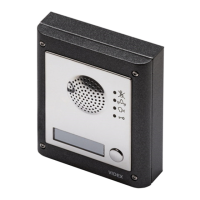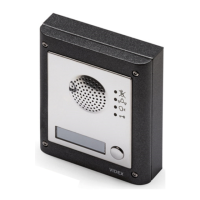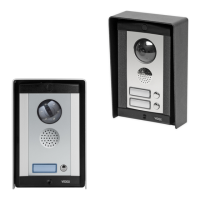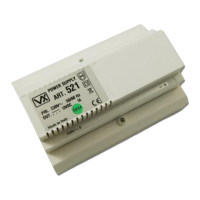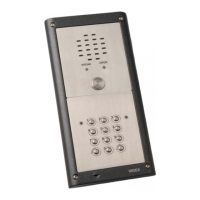66250754-4G-EN - V2.0 - 28/03/22
- 4 -
4000 Series GSM Audio Intercom - Technical Manual
4000 Series GSM Audio Intercom with Proximity
Introduction
MANUAL INTRODUCTION
The information in this manual is intended as an installation and commissioning guide for the 4000 series 4G GSM audio intercom
system. This manual should be read carefully before the installation commences. Any damage caused to the equipment due to
faulty installation where the information in this manual has not been followed is not the responsibility of VIDEX Electronics S.P.A. and
VIDEX Security Ltd (UK).
It is recommended that the GSM audio intercom is installed by a competent electrician, security or communications engineer.
For UK customers Videx run free training courses for engineers who are unfamiliar or who have not installed this system before.
Technical help is also available for UK customers on tel: 0191 224 3174 during oce hours (8:30am - 5:00pm MON to FRI) or via e-mail:
tech@videxuk.com and for all overseas customers on tel: +39 0734 631669 or via e-mail: technical@videx.it.
A copy of this Technical Manual can be downloaded from the VIDEX websites: For UK customers www.videxuk.com and for overseas
customers www.videx.it.
SYSTEM INTRODUCTION
The 4G GSM intercom (Art.4810/4G) is designed to work on the same technology as mobile phones, specically a 4G network, however
it is compatible with both 2G and 3G networks. As the 4G GSM is a global module it can be used around the world. It enables a call to
be made from an entry point (door, gate etc), to any telephone number (mobile or land line). Up to 50 call buttons can be connected
to the door panel, each able to call four telephone numbers (if the rst is busy or not answered, the call can be diverted to up to three
dierent numbers). Features of the system include:
• A dry contact relay output and push to exit input.
• Two open collector auxiliary outputs and two auxiliary inputs.
• Integrated Proximity Access Control (up to 1000 proximity fob/card capacity, when presented to the nameplate window on
the GSM intercom or directly in front of the Art.4850R expansion reader will activate the door/gate relay).
• Call progress speech annunciation and call progress LED indication.
• Dial to Open facility (this feature enables up to 1000 stored DTO numbers and 32 temporary DTO numbers to dial the GSM
intercom, the intercom will not answer these calls, but will activate the door/gate relay without being charged for the call).
• Programmable call button timeband facility (a single timeband only).
• Programmable access control timeband facility (up to 10 timebands).
• Programmable free access timeband facility (up to 10 timebands).
• Up to 10 programmable access levels.
• Automatic time correction features and daylight saving time adjustment.
• Micro USB connection for ease of programming using the GSMSK PC software (version 4.1.0.35 or later).
• RS485 bus for connecting additional Art.4903 keypads and/or Art.4850R proximity readers (up to a maximum of 8
devices), also for connecting Art.2813 RS485 remote relays (up to a maximum of 64 remote relay units). The RS485 bus can
also be used for ease of programming using the GSMSK PC software.
• When connected via RS485 to the Art.4903 keypad allows up to 400 permanent access codes and 32 temporary access codes
to be programmed with access control timeband and access level features.
• Includes a facility to remotely program the GSM module ‘over the air’ using the GSMSK PC software without the need to
actually connect a PC or laptop directly to the intercom via the USB or RS485 connections.
• Event logging system that can record up to 4000 events which can be downloaded via the GSMSK PC software.
• Remote event logging facility (unlimited events) which can be monitored in real time (see user management notes, page 75).
• Integrated bootloader function for updating intercom panel rmware via the GSMSK PC software.
Programming of the telephone numbers (primary, diverts and dial to open numbers) and additional features including programming
key fobs for the proximity reader and additional proximity readers, programming access codes for additional coded keypads, timebands,
access levels etc. can be carried out via text messaging (see programming the GSM intercom notes, pages 37 - 66) or using the GSMSK
PC software (refer to the manual GSMSK_66251720-EN_V2-1 or later) by direct USB or RS485 connection to a PC or remotely via the
‘over the air’ feature (the PC software can still be used to program the GSM intercom, but the PC is not directly connected to it via the
USB or RS485 connection, further details can be found on pages 61 - 62).
Alternatively a limited number of programming features can be carried out using the Videx SMS Wizard (for administrators) or for
more in depth programming using the Videx SMS Wizard PRO (for installers), see notes on the GSM mobile Apps on page 67.
SIM CARD SELECTION
IMPORTANT: A SIM IS REQUIRED FOR THIS PRODUCT BUT NOT SUPPLIED BY VIDEX.
THE 4G GSM INTERCOM CAN ONLY ACCEPT A NANO SIZE SIM CARD, BOTH A STANDARD SIZE
SIM AND MICRO SIM ARE NOT SUITABLE.
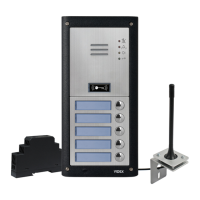
